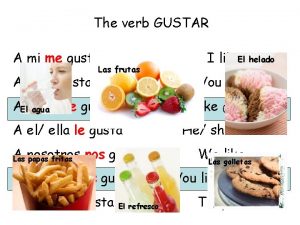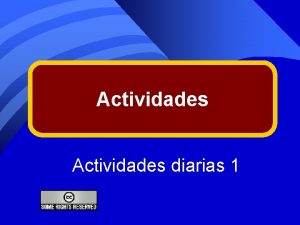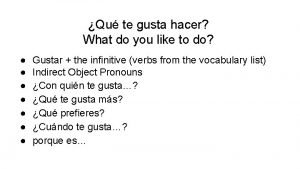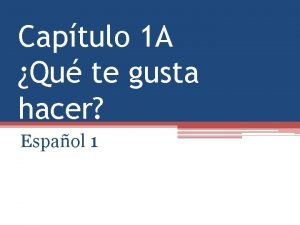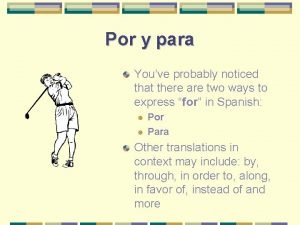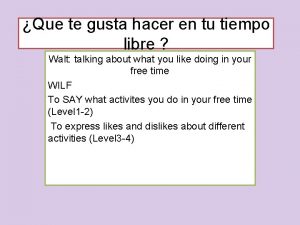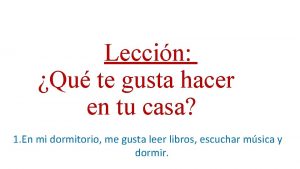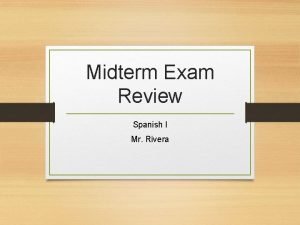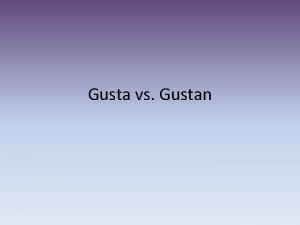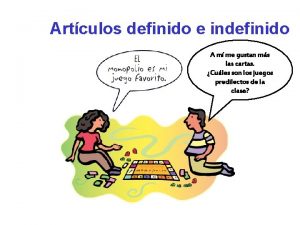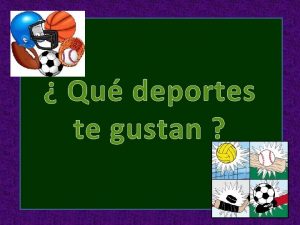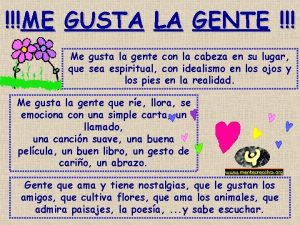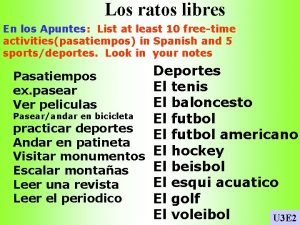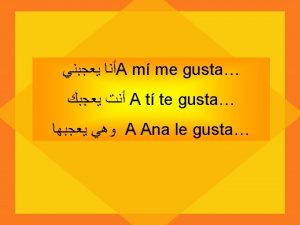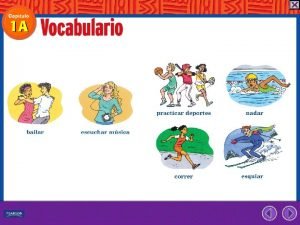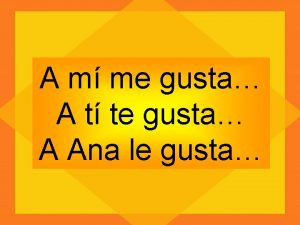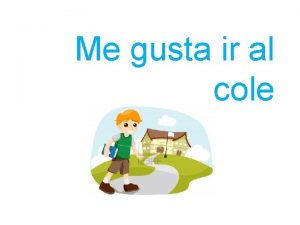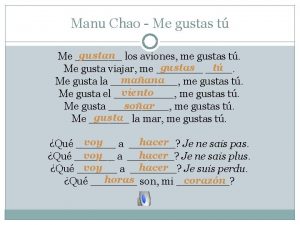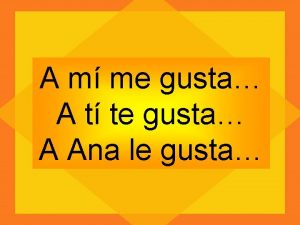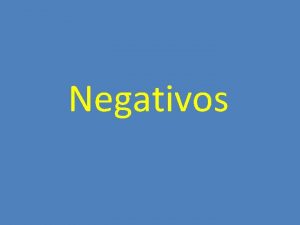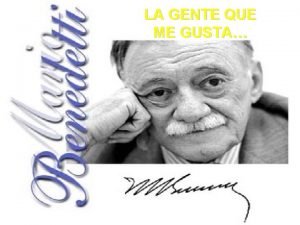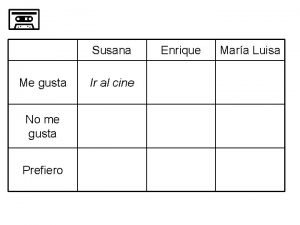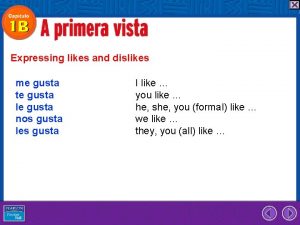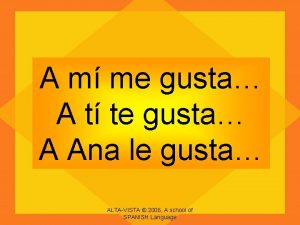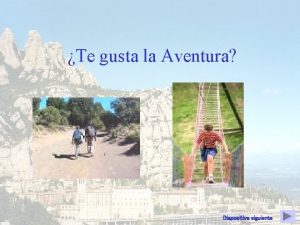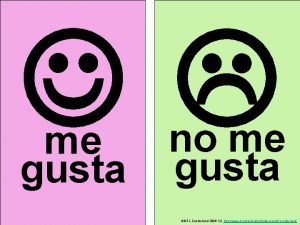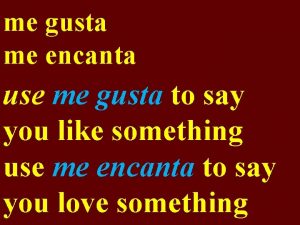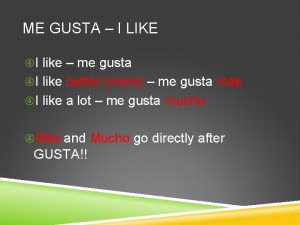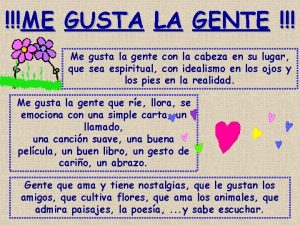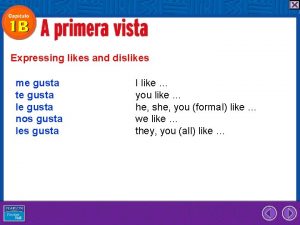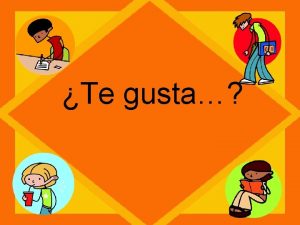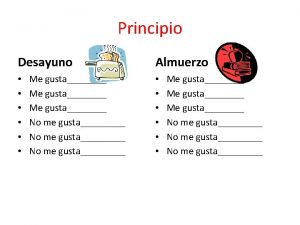Qu te gusta hacer Qu te gusta hacer





































- Slides: 37

¿Qué te gusta hacer?

¿Qué te gusta hacer?

Y tú, ¿cómo eres?

Y tú, ¿cómo eres?

Infinitives Verbs are words that are most often used to name actions. The most basic form of a verb is called the infinitive. In English, you can spot infinitives because they usually have the word “to” in front of them. Spanish infinitives are only one word, and always end in -ar, -er, or -ir: nadar, leer, escribir

The verb gustar It’s easy to talk about the things you like to do once you know the infinitive. Just add the infinitive to te gusta or me gusta. ¿Te gusta practicar deportes? Sí, me gusta correr.

Adjectives Words that describe people and things are called adjectives (adjetivos). In Spanish, most adjectives have both masculine and feminine forms. The masculine form usually ends in the letter -o and the feminine form usually ends in the letter -a.

Adjectives Masculine adjectives are used to describe masculine nouns and feminine adjectives are used to describe feminine nouns. Paco es ordenado y simpático. Marta es ordenada y simpática.

Adjectives that end in -e describe both masculine and feminine nouns. Anita es inteligente y Pedro es inteligente también.

Adjectives When the masculine form of an adjective ends in -or, its feminine form ends in -ora. Juan Carlos es trabajador y Marilú es trabajadora también.

Adjectives Some adjectives that end in -a, such as deportista, describe both masculine and feminine nouns. You will need to learn which adjectives follow this pattern. Tomás es deportista y Raquel es deportista también.

Tu día en la escuela

Tu día en la escuela

Tu sala de clases

¡Hola! ¿Cómo estás?

Subject pronouns The subject of a sentence tells who is doing the action. You can also use subject pronouns, which replace people’s names. Eduardo toca muy bien la guitarra. Laura y yo practicamos muchos deportes. Él toca muy bien la guitarra. Nosotros practicamos muchos deportes. Here are the subject pronouns in Spanish:

Subject pronouns

Present tense of –ar verbs You will want to use verbs in ways other than in the infinitive form. To create the present-tense form of most -ar verbs, you first drop the -ar ending, leaving the stem. Then you add new endings to the stem. These verb endings tell you who is doing the action. Here are the present-tense forms of the verb hablar:

Present tense of –ar verbs (yo) hablo (tú) hablas Ud. (él) habla (ella) (nosotros) hablamos (nosotras) (vosotros) (vosotras) habláis Uds. (ellos) (ellas) hablan

¿Desayuno o almuerzo?

¿Desayuno o almuerzo?

Para mantener la salud

Para mantener la salud

Present tense of –er and –ir verbs To create the present-tense forms of -er and -ir verbs, drop the endings from the infinitives, and add the appropriate verb endings to the stem.

Present tense of –er and –ir verbs Here are the present-tense forms of regular –er verbs:

Present tense of –er and –ir verbs Here are the present-tense forms of regular –ir verbs:

The plurals of adjectives Just as adjectives agree with nouns depending on whether they are masculine or feminine, they also agree according to whether the nouns are singular or plural. To make adjectives plural, just add -s after the vowel at the end of the adjective. If the adjective ends in a consonant, add -es. La manzana es buena para la salud. Las manzanas son buenas para la salud. El pastel aquí es popular. Los pasteles del Café Nuñoz son populares.

The plurals of adjectives When an adjective describes a group including both masculine and feminine nouns, use the masculine plural form. Las zanahorias y los tomates son buenos para la salud.

¿Adónde vas?

¿Adónde vas?

¿Quieres ir conmigo?

¿Quieres ir conmigo?

Asking questions In Spanish, when you ask a question with an interrogative word (who, what, where, etc. ), you put the verb before the subject. ¿Qué bebe María en el café? ¿Por qué estudian Juan y Flor en la biblioteca?

Asking questions Here are some interrogative words you know: ¿Qué? ¿Cómo? ¿Quién(es)? ¿Con quién(es)? ¿Dónde? ¿Cuántos(as)? ¿Adónde? ¿De dónde? ¿Cuál? ¿Por qué? ¿Cuándo?

Ir + a + infinitive Just as you use “to be going” + an infinitive in English to say what you are going to do, in Spanish you use a form of the verb ir + an infinitive to express the same thing. Voy a correr hoy. ¿Tú vas a jugar al golf esta tarde?

The verb jugar Use the verb jugar to talk about playing a sport or a game. Even though jugar uses the same endings as the other -ar verbs, it has a different stem in some forms. For those forms, the -u- becomes -ue-. This kind of verb is called a “stem-changing verb. ”

The verb jugar Here are the present-tense forms of jugar:
 Como me gusta lo que me encanta
Como me gusta lo que me encanta A mi me gusta a ti te gusta
A mi me gusta a ti te gusta Qué actividades te gusta realizar
Qué actividades te gusta realizar No me gusta
No me gusta Lectura que te gusta hacer pp 40-41 answers
Lectura que te gusta hacer pp 40-41 answers María estudia ___ dentista.
María estudia ___ dentista. Qué te gusta hacer en tu tiempo libre?
Qué te gusta hacer en tu tiempo libre? Gusta i
Gusta i Que te gusta hacer en vacaciones
Que te gusta hacer en vacaciones ¿qué te gusta hacer en casa?
¿qué te gusta hacer en casa? Me gusta la gente seria
Me gusta la gente seria Proyecto de vida que me gusta
Proyecto de vida que me gusta Carlos, pedro y yo del fútbol pero no nos gusta.
Carlos, pedro y yo del fútbol pero no nos gusta. Me gusta la gente mario benedetti
Me gusta la gente mario benedetti Gusta vs gustan
Gusta vs gustan Pensamientos sobre la catequesis
Pensamientos sobre la catequesis Cara triste
Cara triste Me gusta indefinido
Me gusta indefinido Les gusta probar ideas teorías y técnicas nuevas
Les gusta probar ideas teorías y técnicas nuevas Me gusta jugar deportes
Me gusta jugar deportes A nosotros gusta la pizza
A nosotros gusta la pizza Me gusta la gente que
Me gusta la gente que A mí me gusta la
A mí me gusta la ¿te gusta jugar (to play) 1 of 1 en tus ratos libres?
¿te gusta jugar (to play) 1 of 1 en tus ratos libres? La gente que me gusta benedetti
La gente que me gusta benedetti Me gusta andar en bicicleta
Me gusta andar en bicicleta To use me gusta and me encanta to talk about
To use me gusta and me encanta to talk about Porque me gusta
Porque me gusta Soy ignacio me gusta mucho tocar la guitarra in english
Soy ignacio me gusta mucho tocar la guitarra in english A esteban le gusta tocar la guitarra.
A esteban le gusta tocar la guitarra. A juan _____ gusta la comida. me te nos le
A juan _____ gusta la comida. me te nos le Jaime sabines a mi me encanta dios
Jaime sabines a mi me encanta dios Con la gente que me gusta compositor
Con la gente que me gusta compositor Me gusta + infinitive
Me gusta + infinitive Me gusta el cole
Me gusta el cole Me gusta el avion
Me gusta el avion A juan _____ gusta la comida. me te nos le
A juan _____ gusta la comida. me te nos le Mario benedetti me gusta la gente
Mario benedetti me gusta la gente

